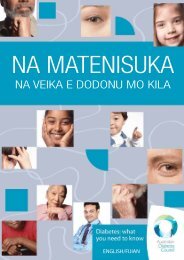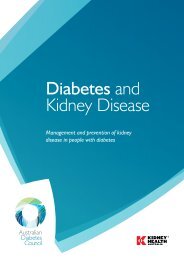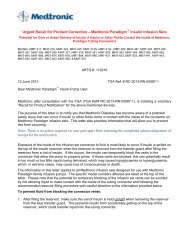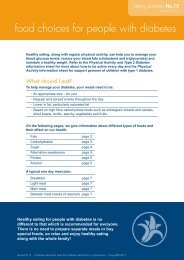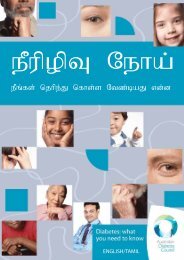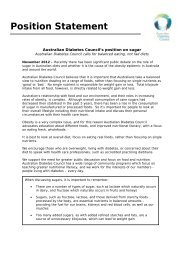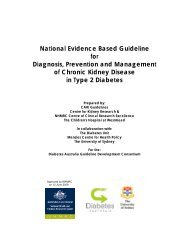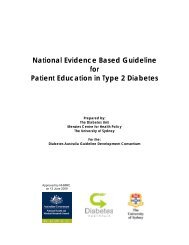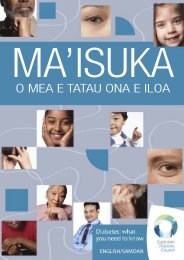Tovi J, Svanborg E, Nilsson BY, Engfeldt P. Diabetic neuropathy <strong>in</strong> elderly <strong>Type</strong> 2 diabetic patients:effects <strong>of</strong> <strong>in</strong>sul<strong>in</strong> treatment. Acta Neurol Sc<strong>and</strong> 1998;98:346-53.Trautner C, Haastert B, Spraul M, Giani G, Berger M. Unchanged <strong>in</strong>cidence <strong>of</strong> lower-limb amputations<strong>in</strong> a German city, 1990-1998. <strong>Diabetes</strong> Care 2001;24:855-9.Turner R, Cull C, Holman R, for the United K<strong>in</strong>gdom Prospective <strong>Diabetes</strong> Study Group. UnitedK<strong>in</strong>gdom Prospective <strong>Diabetes</strong> Study 17: A 9-year update <strong>of</strong> a r<strong>and</strong>omized, controlled trial on theeffect <strong>of</strong> improved metabolic control on complications <strong>in</strong> non-<strong>in</strong>sul<strong>in</strong>-dependent diabetes mellitus. AnnIntern Med 1996;124:136-45.Uhlenbruck C, Chantelau E. The effect <strong>of</strong> diabetic polyneuropathy on the load distribution at theplantar pedis <strong>in</strong> response to hyperkeratosis. <strong>Diabetes</strong> und St<strong>of</strong>fwechsel 1998;7:131-5.UKPDS 27. UK Prospective <strong>Diabetes</strong> Study 27. Plasma lipids <strong>and</strong> lipoprote<strong>in</strong>s at diagnosis <strong>of</strong> NIDDMby age <strong>and</strong> sex. <strong>Diabetes</strong> Care 1997;20:1683-7.Veves A, Uccioli L, Manes C, Van Acker K, Komn<strong>in</strong>ou H, Philippides P, Katsilambros N, De Leeuw I,Menz<strong>in</strong>ger G, Boulton AJM. Comparison <strong>of</strong> risk factors for foot problems <strong>in</strong> diabetic patients attend<strong>in</strong>gteach<strong>in</strong>g hospital outpatient cl<strong>in</strong>ics <strong>in</strong> four different European States. Diabet Med 1994;11:709-13.Vijay V, Snehalatha C, Seena R, Ramach<strong>and</strong>ran A. The Rydel Seiffer tun<strong>in</strong>g fork: an <strong>in</strong>expensivedevice for screen<strong>in</strong>g diabetic patients with high-risk foot. Pract <strong>Diabetes</strong> Int 2001;18:155-6.V<strong>in</strong>ik AI, Holl<strong>and</strong> MT, Le Beau JM, Liuzzi FJ, Stansberry KB, Colen LB. Diabetic neuropathies.<strong>Diabetes</strong> Care 1992;15:1926-75.Vogelberg KH, Stork W. Measurement <strong>of</strong> pulse reappearance time <strong>in</strong> diagnosis <strong>of</strong> peripheral vasculardisease <strong>in</strong> diabetes. <strong>Diabetes</strong> Care 1988;11:345-50.Wall B. Assessment <strong>of</strong> ischaemic feet <strong>in</strong> diabetes. J Wound Care J 1997;6:32-8.Watson J, Obersteller EA, Rennie L, Whitbread C. Diabetic foot care: develop<strong>in</strong>g culturallyappropriate educational tools for Aborig<strong>in</strong>al <strong>and</strong> Torres Strait Isl<strong>and</strong>er peoples <strong>in</strong> the NorthernTerritory, Australia. Aust J Rural Health 2001;9:121-6.Weaver FM, Burdi MD, P<strong>in</strong>zur MS. Outpatient foot care: correlation to amputation levels. <strong>Foot</strong> AnkleInt 1994;15:498-501.Wieman TJ, Griffiths GD, Polk HCJr. Management <strong>of</strong> diabetic midfoot ulcers. Ann Surg1992;215:627-32.W<strong>in</strong>slow EH, Jacobson AF. Research for practice. Sav<strong>in</strong>g limbs with the Semmes-We<strong>in</strong>ste<strong>in</strong>mon<strong>of</strong>ilament. Am J Nurs 1999;99:76.Wollesen F, Dahlen G, Berglund L, Berne C. Peripheral atherosclerosis <strong>and</strong> serum lipoprote<strong>in</strong>(a) <strong>in</strong>diabetes. <strong>Diabetes</strong> Care 1999;22: 93-8.Wooldridge J, Bergeron J, Thornton C. Prevent<strong>in</strong>g diabetic foot disease: lessons from the medicaretherapeutic shoe demonstration. Am J Public Health 1996;86:935-8.Wunderlich RP, Armstrong DG, Husa<strong>in</strong> SK, Lavery LA. Def<strong>in</strong><strong>in</strong>g loss <strong>of</strong> protective sensation <strong>in</strong> thediabetic foot. Adv Wound Care 1998;11:123-8.Wysocki AB. A review <strong>of</strong> the sk<strong>in</strong> <strong>and</strong> its appendages. Adv Wound Care 1995;8:53-70.Zimny S, Dessel F, Ehren M, Pfohl M, Schatz H. Early detection <strong>of</strong> micorcirculatory impairment <strong>in</strong>diabetic patients with foot at risk. <strong>Diabetes</strong> Care 2001;24:1810-4.124
2.6 <strong>Diabetes</strong> <strong>Foot</strong> Problem Guidel<strong>in</strong>e Search Strategy <strong>and</strong> YieldElectronic Databases Searched:Medl<strong>in</strong>eCINAHLEMBASECochraneTerms used to search the databases:Detailed with<strong>in</strong> the table below.Search Inclusion Criteria:Where possible the searches were limited by the English language <strong>and</strong> human research. The databases were searched for the follow<strong>in</strong>g years <strong>of</strong> publication: Medl<strong>in</strong>e 1966-2004; CINAHL 1982-2004;EMBASE 1988-2004; Cochrane 1993-2004; Unless other year ranges are specified. PsycInfo <strong>and</strong> Sociological Abstracts were searched for the follow<strong>in</strong>g years <strong>of</strong> publication <strong>of</strong> socioeconomic issues:1994-2004.Other search<strong>in</strong>g:Reference lists at the end <strong>of</strong> review articles <strong>of</strong> particular relevance were h<strong>and</strong> searched.Relevant articles were solicited from expert colleagues <strong>and</strong> organisations.Local <strong>and</strong> <strong>in</strong>ternational cl<strong>in</strong>ical practice guidel<strong>in</strong>es were reviewed for relevant references.Abbreviations:The database searched has been <strong>in</strong>dicated next to each set <strong>of</strong> keywords us<strong>in</strong>g the follow<strong>in</strong>g abbreviations. M = Medl<strong>in</strong>e, CI = CINAHL, EM = EMBASE <strong>and</strong> CO = Cochrane. All EMBASE <strong>and</strong> Medl<strong>in</strong>esearches were done us<strong>in</strong>g English language (En.La) <strong>and</strong> human as a limit. The symbol / after a word <strong>in</strong>dicates that it is a MeSH term <strong>and</strong> any article found by this method has been allocated to this subjecthead<strong>in</strong>g used <strong>in</strong> the database; .mp <strong>in</strong>dicates that that word was searched as a keyword <strong>in</strong> the database. Other abbreviations used were: NIDDM = non-<strong>in</strong>sul<strong>in</strong>-dependent diabetes mellitus; RCT =r<strong>and</strong>omised controlled trial; CVD = cardiovascular diseases; PVD = peripheral vascular diseases; IC = <strong>in</strong>termittent claudication; CBD = cerebrovascular disorders; bl = blood; cl = classification; co =complications; dh = diet therapy; di = diagnosis; dm = disease management; dt = drug therapy; ep = epidemiology; et = etiology; mo = mortality; nu = nurs<strong>in</strong>g; pa = pathology; pc = prevention <strong>and</strong>control; pp = pathophysiology; px = psychology; rh = rehabilitation; si = side effects; th = therapy.Identified = number <strong>of</strong> articles which matched the MeSH terms listed or conta<strong>in</strong>ed the text terms <strong>in</strong> each particular database.Relevant = those articles considered relevant to the questions be<strong>in</strong>g asked after view<strong>in</strong>g titles or abstracts.Articles Identified by Other Strategies = articles identified by h<strong>and</strong> search<strong>in</strong>g, other searches for other questions, or from colleagues.Total for Review = relevant articles for each question identified through searches or other strategies <strong>and</strong> met the follow<strong>in</strong>g criteria.125
- Page 1:
National Evidence Based Guidelinesf
- Page 4:
Research OfficersMs Linda SmithPodi
- Page 7 and 8:
2.2 Issues for Foot Problems in Typ
- Page 9:
• Aim to achieve the best possibl
- Page 12 and 13:
Background - Peripheral Neuropathy
- Page 14 and 15:
proportion of subjects with a durat
- Page 16 and 17:
and an OR 1.1-7.8. This study also
- Page 18 and 19:
Summary - Peripheral Neuropathy as
- Page 20 and 21:
Section 2: Diabetes Foot ProblemsIs
- Page 22 and 23:
predicting risk of amputation, 2.9
- Page 24 and 25:
Summary - Peripheral Vascular Disea
- Page 26 and 27:
Section 3: Diabetes Foot ProblemsIs
- Page 28 and 29:
Evidence - Foot Deformity and Previ
- Page 30 and 31:
people with both LJM and neuropathy
- Page 32 and 33:
Summary - Foot Deformity and Previo
- Page 34 and 35:
Section 4: Diabetes Foot ProblemsIs
- Page 36 and 37:
Also in the Seattle study, 67 peopl
- Page 38 and 39:
Summary - Ulcer as a Risk Factor fo
- Page 40 and 41:
Section 5: Diabetes Foot ProblemsIs
- Page 42 and 43:
The other frequently reported metho
- Page 44 and 45:
side; and 82% having the same resul
- Page 46 and 47:
Evidence Table: Section 5Detection
- Page 48 and 49:
Background - Clinical Detection of
- Page 50 and 51:
pulse was bilaterally absent in 1.8
- Page 52 and 53:
Evidence Table: Section 6AuthorClin
- Page 54 and 55:
Background - Frequency of Foot Exam
- Page 56 and 57:
Summary - Frequency of Foot Examina
- Page 58 and 59:
Section 8: Diabetes Foot ProblemsIs
- Page 60 and 61:
Behaviour assessment scores, measur
- Page 62 and 63:
Mazzuca et al (1986) studies 532 pe
- Page 64 and 65:
with before the programme, after 1-
- Page 66 and 67:
Evidence Table: Section 8AuthorEffe
- Page 68 and 69:
Background - Glycaemic Control and
- Page 70 and 71:
In a previous Japanese randomised s
- Page 72 and 73:
Evidence Table: Section 9AuthorGlyc
- Page 74 and 75: Background - Footwear to Reduce Ulc
- Page 76 and 77: period. In addition people without
- Page 78 and 79: Comparisons of in-shoe foot pressur
- Page 80 and 81: The rate of plantar callus formatio
- Page 82 and 83: Evidence Table: Section 10AuthorFoo
- Page 84 and 85: Background - Foot Clinics and Multi
- Page 86 and 87: A prospective non randomised contro
- Page 88 and 89: Summary - Foot Clinics and Multi-di
- Page 90 and 91: Section 12: Diabetes Foot ProblemsI
- Page 92 and 93: and/or osteomyelitis; III - fore-fo
- Page 94 and 95: Summary - Economic consequences•
- Page 96 and 97: Section 13: Diabetes Foot ProblemsI
- Page 98 and 99: Some ethnic groups are associated w
- Page 100 and 101: Evidence Table: Section 13AuthorSoc
- Page 102 and 103: Calle-Pascual AL, Duran A, Diaz A,
- Page 104 and 105: Jannink MJ, van Dijk H, de Vries J,
- Page 106 and 107: Moss SE, Klein R, Klein BE. The 14-
- Page 108 and 109: Soulier SM, Godsey C, Asay ED, Perr
- Page 110 and 111: Diabetes Foot Problems: General Ref
- Page 112 and 113: McNeely MJ, Boyko EJ, Ahroni JH, St
- Page 114 and 115: Diabetes Foot Problems: Other Refer
- Page 116 and 117: Caputo GM, Cavanagh PR, Ulbrecht JS
- Page 118 and 119: Garbalosa JC, Cavanagh PR, Wu G, Ul
- Page 120 and 121: Lavery LA, Armstrong DG, Wunderlich
- Page 122 and 123: Payne C. Regional variations of dia
- Page 126 and 127: Criteria used to determine the suit
- Page 128 and 129: QUESTIONS KEY WORDS NO.ARTICLESIDEN
- Page 130 and 131: QUESTIONS KEY WORDS NO.ARTICLESIDEN
- Page 132 and 133: QUESTIONS KEY WORDS NO.ARTICLESIDEN
- Page 134 and 135: QUESTIONS KEY WORDS NO.ARTICLESIDEN
- Page 136 and 137: QUESTIONS KEY WORDS NO.ARTICLESIDEN
- Page 138 and 139: QUESTIONS KEY WORDS NO.ARTICLESIDEN



